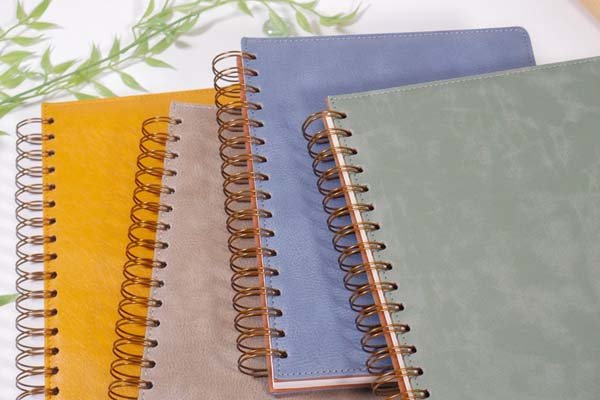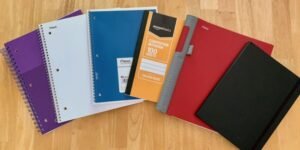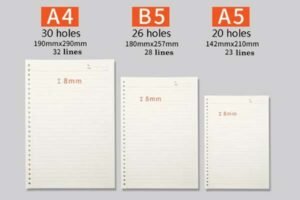
Choosing the right binder size feels complicated sometimes. You worry that picking the wrong one means pages falling out or carrying something too bulky. Understanding the differences helps you choose the perfect fit for your needs.
Neither long nor short binders1 are automatically "better." The best choice depends completely on how you'll use it, considering page capacity, how portable it needs to be, and your specific tasks.
This choice impacts more than just size. It changes how many pages fit inside, how easy the binder is to carry around, and even how comfortably you can write or organize notes. At NotebookRing®, we've seen how important the right size is for our clients over the years. We make binders in many standard sizes, like A4, Letter, A5, and B6, and we also create custom sizes based on unique needs.
Let's break down the key differences. Long binders, usually A4 or Letter size, hold more paper. They are great for big projects, lots of school notes, or storing standard printed documents without folding. Short binders, like A5 or B6, are much easier to carry. They fit well in bags and are perfect for notes on the go, journaling, or planners. The best one for you really comes down to function over form.
Why are spiral notebooks2 sometimes preferred?
Spiral notebooks are everywhere, and lots of people prefer them. But what makes them a good choice compared to a traditional ring binder, especially considering the different needs we just talked about?
Spiral notebooks are often chosen for their ability to lay completely flat or fold back 360 degrees, making writing easy. They also tend to be slimmer and lighter than ring binders holding the same amount of paper.

Spiral Notebook Advantages
Let's look closer at why spirals work so well for certain situations.
The Lay-Flat Writing Experience
One of the biggest advantages is how they open. A spiral binding allows the notebook to lie perfectly flat on a desk. This means no awkward bump in the middle like you sometimes get with ring binders. It also means you can fold the cover all the way back, giving you a sturdy writing surface even if you don't have a table. This is especially helpful for left-handed writers who might find rings get in the way. At NotebookRing®, we even developed a patented "seamless coil" technology to make sure the spiral feels smooth and doesn't snag clothes. [Placeholder for a brief personal story about observing customers value the lay-flat feature]
Portability and Design
Spiral notebooks usually have a slimmer profile than ring binders. The spiral itself takes up less space than metal rings and a binder cover mechanism. This makes them lighter and easier to slip into a bag or backpack.
Here's a quick comparison table for a typical A5 size:
| Feature | Spiral Notebook (100 sheets) | Ring Binder (100 sheets) |
|---|---|---|
| Lay-Flat | Excellent (360° fold-back) | Good (180°+) |
| Profile/Bulk | Slimmer | Bulkier (due to rings) |
| Page Flexibility | Fixed Pages | Add/Remove Pages Easily |
| Spine Durability | Spiral can bend/crush | Mechanism generally robust |
| Typical Use Case | Note-taking, journaling | Organizing, archiving |
Customization Potential
While you can't easily add or remove pages like in a ring binder, spirals still offer a lot of customization. We can customize the coil size and color, the cover material (from sturdy PP plastic to elegant cloth hardcover), and of course, the inner pages (paper weight, ruling, printing). We often create spiral notebooks with durable covers for students or professionals who need something tough but portable.
Considerations
It's also fair to point out the downsides. The spiral itself can sometimes get bent or crushed if not handled carefully. And, as mentioned, you can't reorganize or refill pages easily. If you need that flexibility to add, remove, and reorder content, a ring binder is probably the better tool for the job.
When is a Long Binder the Right Choice?
Sometimes, you simply need the extra space. So, when does choosing a larger format binder, like an A4 or US Letter size, make the most sense for your project or daily use?
Long binders are ideal when you need maximum paper capacity for extensive notes or documents, need to store standard-sized printouts, or will primarily use the binder at a stationary location like a desk.
Long Binder Uses
Larger binders serve specific purposes very well.
Handling High Volumes
If you're dealing with a lot of information for one topic – like comprehensive study notes for a subject, materials for a major work project, or training manuals – a long binder is often necessary. Its larger page size and typically higher ring capacity mean you can keep everything together without needing multiple volumes. We often produce high-capacity A4 binders for educational institutions using durable rings and covers.
Compatibility with Standard Documents
Most office printouts, reports, and academic papers are A4 or Letter size. A long binder allows you to hole-punch and insert these documents directly without folding or trimming them. This is essential for professional organization and easy reference. [Placeholder for a brief anecdote about a corporate client needing binders for training materials]
Ideal for Desktop Use
When portability isn't the main concern, the larger footprint of a long binder is less of a drawback. They sit stably on a desk and are great for building reference archives, organizing research, or managing ongoing projects that you primarily access in one place. The larger page size also offers more writing space per page, which some people prefer.
Presentation and Professionalism
For certain uses, like creating portfolios, presenting reports, or compiling formal documents, the larger format of a long binder can lend a more substantial and professional appearance. We offer various customization options like hot stamping or embossing on covers to enhance this professional look.
When is a Short Binder the Best Option?
Bigger isn't always better. Compactness and portability are key in many situations. So, when should you reach for a smaller binder, like an A5, B6, or even a pocket size?
Short binders excel when portability is key. They are perfect for journaling, meeting notes, travel logs, daily planning, or any time you need a lightweight, easy-to-carry notebook solution.
Short Binder Uses
Smaller binders offer distinct advantages for mobility and specific tasks.
Perfect for On-the-Go Needs
This is the primary reason people choose short binders. Their smaller size and lighter weight make them easy to carry in a purse, backpack, or even a large pocket. They are ideal for taking notes during meetings, conferences, site visits, or while traveling. We make many A5 and B6 binders specifically because our clients need something easy to manage away from their desks.
Suited for Specific, Focused Uses
Short binders are great for dedicated tasks that don't require massive page counts. Think recipe books, personal journals, address books, project-specific planners, or field notes. The A5 size, in particular, is very popular as it balances portability with adequate writing space. Our compatibility with standard 6-hole systems (like Filofax) makes these highly versatile.
Reducing Desk Clutter
If you prefer a minimalist workspace, smaller notebooks and binders naturally take up less room. Using short binders for different projects or subjects can help keep your desk more organized compared to having several large binders.
Potential Cost-Effectiveness for Bulk Orders
While not always the case, smaller binders use less material (paper, cover board, metal). For large custom orders, this can sometimes translate into cost savings per unit. It's something we discuss with clients like James Wong from Singapore when planning bulk corporate gift orders.
Partnering with NotebookRing® for Your Binder Needs
Choosing the right binder or notebook boils down to understanding your specific requirements. Whether it's a long binder for extensive notes, a short one for portability, or a lay-flat spiral notebook, the construction and quality matter immensely. That's where we, NotebookRing®, come in.
Since 2006, we've focused on manufacturing high-quality notebooks and binders. We operate our own 15,000㎡ factory, controlling the process from raw materials like FSC-certified paper and durable metal rings to the finished product. This vertical integration allows us to ensure quality and offer flexibility.
We specialize in customization. Need a specific size? We can do it. Want a unique cover process like hot stamping, laser engraving, or embossing? We offer those. Need specific inner page formats or paper types, like acid-free, recycled, or even Tomoe River paper? We have a wide selection. We manufacture both ring binder mechanisms (compatible with international standards) and spiral coils, including our patented seamless coil.
Our experience working with diverse clients – from German chain bookstores needing eco-certified notebooks to Silicon Valley tech companies ordering custom onboarding kits, and Japanese stationery brands developing specialized products – means we understand different market needs. We can handle both large production runs (over 500,000 notebooks/month capacity) and smaller, flexible orders starting from 100-500 units for basic versions. Quality control is built into our process, meeting standards like ISO 9001, FSC, BSCI, and REACH.
If you're looking for a reliable manufacturing partner for notebooks or binders, we'd love to talk.
Contact me, Timothy Wei, General Manager, at info@notebookring.com or visit www.notebookring.com.
We offer a free physical sample book with material samples and respond to inquiries within 24 hours.
Conclusion
Ultimately, the "best" binder isn't about long versus short, or spiral versus ring. It's about finding the right tool for your specific job – considering capacity, portability, and how you'll use it every day. Understanding these differences helps you choose wisely.





